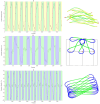Activity Identification, Classification, and Representation of Wheelchair Sport Court Tasks: A Method Proposal
- PMID: 39452798
- PMCID: PMC11510277
- DOI: 10.3390/mps7050084
Activity Identification, Classification, and Representation of Wheelchair Sport Court Tasks: A Method Proposal
Abstract
Background: Monitoring player mobility in wheelchair sports is crucial for helping coaches understand activity dynamics and optimize training programs. However, the lack of data from monitoring tools, combined with a lack of standardized processing approaches and ineffective data presentation, limits their usability outside of research teams. To address these issues, this study aimed to propose a simple and efficient algorithm for identifying locomotor tasks (static, forward/backward propulsion, pivot/tight/wide rotation) during wheelchair movements, utilizing kinematic data from standard wheelchair mobility tests.
Methods: Each participant's wheelchair was equipped with inertial measurement units-two on the wheel axes and one on the frame. A total of 36 wheelchair tennis and badminton players completed at least one of three proposed tests: the star test, the figure-of-eight test, and the forward/backward test. Locomotor tasks were identified using a five-step procedure involving data reduction, symbolic approximation, and logical pattern searching.
Results: This method successfully identified 99% of locomotor tasks for the star test, 95% for the figure-of-eight test, and 100% for the forward/backward test.
Conclusion: The proposed method offers a valuable tool for the simple and clear identification and representation of locomotor tasks over extended periods. Future research should focus on applying this method to wheelchair court sports matches and daily life scenarios.
Keywords: monitoring; paralympic; performance; symbolic aggregate approximation.
Conflict of interest statement
The authors declare no conflicts of interest.
Figures



References
-
- Fu J., Liu T., Jones M., Qian G., Jan Y.K. Characterization of Wheelchair Maneuvers Based on Noisy Inertial Sensor Data: A Preliminary Study; Proceedings of the 2014 36th Annual International Conference of the IEEE Engineering in Medicine and Biology Society; Chicago, IL, USA. 26–30 August 2014; pp. 1731–1734. - DOI - PMC - PubMed
LinkOut - more resources
Full Text Sources

